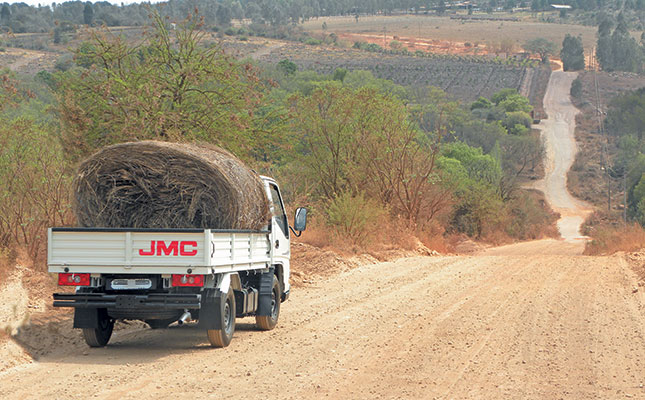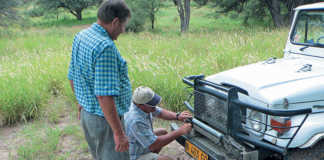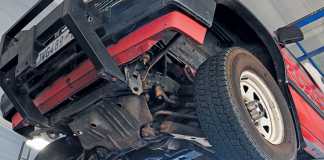
The Chinese-made JMC Carrying 1,6t light truck is an affordable, no-nonsense vehicle, typical of many of the new-generation of vehicles from that far-off country.
When I first received one for a test a year ago, it was brand-new, with just 167km on the clock and a temporary permit stuck onto the rear window. The controls were understandably very stiff and the truck clearly needed to be run in.
I drove it for only about 30km on tar to get a general feel for it and requested it again after it had been run in. The handling as well as the performance and fuel consumption figures at that time would not have been a fair reflection of the vehicle.
Smoother and better
I received the Carrying 1,6t again in September this year, now with 4 760km on the odometer. The gearbox and clutch were far smoother and easier to operate this time around, and the engine seemed ‘looser’.
The 2,8 litre diesel engine started immediately with that typical diesel clatter reminiscent of a tractor engine. It has torque in spades: on the level, I could pull off, drive slowly at idle and park, all in first gear, or change to second without touching the accelerator pedal.
The truck was quite happy to potter around at just above 20km/h in fourth gear, and accelerate smoothly from there to 40km/h, when I could change into fifth.
This typical old-fashioned diesel flexibility is ideal for a hard-working truck. The cab-over-engine configuration is undoubtedly the best use of space. The occupants sit practically over the front wheels with the engine under and in between them. Forward vision is outstanding; comfort on a bumpy road somewhat less so.
The simple and rugged ladder-frame chassis and leaf-sprung, solid-axle suspension, with telescopic shock absorbers fore and aft, is built for years of trouble-free heavy work, but not really for comfort. The massive tow-hook mounting point on the rear of the chassis is one of the best I’ve seen.
Flat and easy-to-use load bin
The loading bin is large and sits above the top level of the rear wheels, so it is completely flat. It has a ribbed surface, and the bin in the test vehicle was rubberised – a non-slip, highly durable and worthwhile non-standard option.
The rear and side flaps all fold down nearly vertically against rubber stops for easy cargo loading/offloading, then fold up again and engage each other with sturdy interlocking levers. Stout lash-down hooks below the flap hinge axis-line make securing the load easy.The Carrying 1,6t is available in long and short wheelbase versions.
The latter, the one tested, was Code 8 licence-legal.
Although a workhorse, the Carrying 1,6t nevertheless caters for the basic comfort of the driver and co-driver. Included are power steering, a heater/air conditioner, electrically operated windows and a radio/CD player, albeit somewhat rough around the edges compared with that found in most passenger vehicles.
The driver’s door armrest carries a central door-locking button, as well as window winder control button. A tough waterproof vinyl-type material covers the floor. The cabin noise level is high – at cruising speed it is just about at speech interference level.
The sound system struggles to compete, merely adding to the din. But in the years to come, improvements in engineering, build quality, functionality and performance are all bound to follow.
Load-carrying ability and handling
I put the handling and loadability of the Carrying 1,6t to the test on three separate occasions on a steep decline and incline on a washed-out track near Zwavelpoort, east of Pretoria.
On the first test, I put a cubic metre of dry lawn dressing, weighing 600kg, on the back. The load dampened the irregularities, axle tramp and wheel spin, and the JMC coped without drama. A few days later, I tried it without the benefit of a load to weigh it down.
It was a different experience entirely – bone-jarring with some wheel spin. The next day, a 150kg round hay bale amidships produced a more or less intermediate result.
On a tar road, with or without a load, I found the JMC inclined to wander somewhat, but soon got used to it and corrected automatically. It might have been something to do with wheel alignment, but I could not confirm it.
The conclusion? Although lacking the sophistication of the typical expensive modern bakkie with electronic trickery that transforms even an idiot driver into an expert, this affordable workhorse will lug a heavy load without fuss or bother to wherever the user wants it.
There are two provisos: take your time, and make full use of the finest vehicle control system ever devised: your hands, feet, eyes and ears.
Fuel usage
Although the engine in essence is an earlier-generation turbodiesel, running it on 50ppm S diesel will do it no harm, according to the distributors. This fact was confirmed to me by our expert in motoring matters, Jake Venter. Fuel consumption over a measured 360km of give-and-take open road, rural gravel roads, freeway and city traffic, including back to its base, was 8,03ℓ/100 km. This is almost exactly the consumption given in the specifications.
Fuel consumption over a measured 360km of give-and-take open road, rural gravel roads, freeway and city traffic, including back to its base, was 8,03ℓ/100 km. This is almost exactly the consumption given in the specifications.
Built to work
The JMC Carrying is a workhorse, with functionality foremost in mind. The design configuration caters particularly well for two important aspects: servicing and repair. The cab tilts forwards and upwards to give ready access to engine, transmission, air conditioner, turbocharger and other components.
The simple hinging mechanism uses foolproof, sturdy and safe interlocking cradles and locking latches. The balance is perfect and the cab can be moved with one hand after the latching safety mechanism has been disengaged. Operation is simple, logical and intuitive, even without the operator manual as backup.
But to merely check and top-up the radiator, hydraulics and engine oil, tilting the cab is not necessary. The operator merely unclips two latches in front of and below the passenger seat, and tilts the seat upwards and backwards to uncover the top of the engine.
The heavy-duty maintenance-free battery is mounted directly onto the chassis on the left under the load bin, readily accessible for servicing and replacement, although vulnerable to theft.
The fuel tank with its lockable filler cap is mounted directly onto the chassis on the opposite side. The heavy-duty, oversized fuel filter incorporates a water trap and bleeding facility. The spare wheel is carried horizontally under the chassis behind the rear axle.
An adequate toolkit
The toolkit consists of a 4t hydraulic jack with a 640mm shaft and separate crank handle to operate its hydraulic valve, a wheel spanner, a set of open spanners, a screwdriver, a pair of pliers and a shifting spanner. There is also a collapsible emergency triangle.
Along with an ABC1-grade dry powder fire extinguisher, these all live behind the driver and central seat, the long ones somewhat awkwardly.
The fact that the driver’s seat backrest is fixed means that some of these items are difficult to remove and secure properly again after use.
Given the maximum permissible rear-axle load of 2 200kg, the jack’s capacity provides a wide margin of safety.
Wheel nuts: to left? to right?
An interesting and valuable technical point is that the wheel stubs and nuts on the right-hand side wheels have right-hand threads, while those on the left hand side wheels have left-hand threads.
This makes perfect sense, as it prevents the force of wheel rotation from spontaneously working the nuts loose when the vehicle is in motion. But a user who has not first read the instruction book will invent a few new expletives when trying to remove a wheel.













